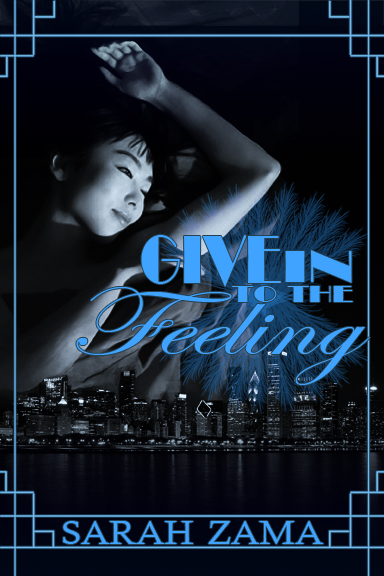I have given my blog to another writer for today. Her name is Sarah Zama and she is an author and bookseller from Verona (Italy). Sarah has always been surrounded by books, especially fantasy ones, and she recently found a home in the dieselpunk community where she is quite the active participant. Sarah is working on a trilogy set in Chicago in 1926, historically as accurate as possible, but also–as with all her stories–very much fantasy. Her first book, Give in to the Feeling, is out now.
So, without further ado, here is Sarah talking about Fantasy’s love affair with History:
 Fantasy is often labeled – by people who don’t read it, I should say – as simple escapism, completely detached from reality. There are many ways to counter this, but I think fantasy’s relationship with history and the progressive influence history and its mechanisms has had on the genre is one of the strongest factors in arguing fantasy’s bond with reality.
Fantasy is often labeled – by people who don’t read it, I should say – as simple escapism, completely detached from reality. There are many ways to counter this, but I think fantasy’s relationship with history and the progressive influence history and its mechanisms has had on the genre is one of the strongest factors in arguing fantasy’s bond with reality.
When non-fans think about fantasy, they think of fantasy from the 1970s. And not surprisingly either, since that was a critical time for the genre. Many past masters who are today considered fathers (and mothers!) of fantasy wrote stories that cemented the tropes that still define the genre.
1970s fantasy is very peculiar that way. The environment – and so worldbuilding – was prominent. Fantasy worlds of this time looked very much medieval, nature influenced characters and their way of life in important ways and magic was spectacular and in your face but also tricky. It spoke of the strength and power of people using it, whether for good or bad. The dichotomy between good and bad was prominent in fantasy stories of that time, as was the internal struggles of the most powerful characters. Michael Moorcock’s Elric of Meliboné series is a very good example here.
These stories are often depicted as taking place in a Medieval-Europe-like world. You may think they were inspired by the Middle Ages, right? Well, that version of the medieval period never existed. 1970s fantasy stories were very rarely inspired by history and were more often a romanticized, idealized version of medieval Europe. It was also a time where the relationship between fantasy and history was the poorest.
In the early 90s, David Gemmell wrote the duology, The Lion of Macedon. This work presents two interesting aspects: first, it wasn’t set in medieval Europe but in ancient Greece. And secondly, he created his world around real historical events and figures, combining culture and myths and beliefs. And he wove his fantasy creation through the fabric of this realistic portrayal of ancient Greece.
It may seem a small thing but it speaks of a profound evolution in world-building and language used in the genre back then.
I find it interesting that it started by merging fantasy and history. I think it’s because it looks to me as if a conscious effort was made to bring fantasy into a recognizably realistic context. The deeper meaning of the genre didn’t change, but the way it expressed itself sure did.
Authors who wrote in the 90s proved that fantasy and reality did exist separately. That they could work together and still make sense in glorious ways.
I like 1990s/2000s fantasy stories because that time was all about exploring and subverting the classic tropes. The showy magic that could do nearly everything disappeared from fantasy and gave space to a more subtle form of magic that was there whether it could be seen or not. The inner workings of history became more and more important to the creation of fantasy worlds.
When Stephen Nicholls wrote his first Orcs Trilogy in the late 90s he built his own fantasy world, but that world had an internal history that was extremely realistic. He subverted classic tropes by making Orcs the heroes. He gave them a culture and a social organization that was anthropologically acceptable and logical.
From the late 1990s through the 2000s authors explored large and wide in an unprecedented effort at innovation. They explored different cultures. Daniel Abraham’s Long Prince Quartet, based on Japan’s history and culture and with his mind-blowing magic system based on poetry, is one of my favorite examples here. Authors innovated language as well. It became grittier and was miles away from the pseudo-Medieval language readers associated with classic fantasy.
I think the increasingly close relationship between fantasy and history caused, or at the very least, contributed to the coming-of-age of the genre. It proves that fantasy isn’t as disconnected from reality as it may seem at first.
Now let’s see what the future holds. I’m excited!
Sarah
To find out more about this author, visit her blog or connect with her on Twitter. As for her new book:
Give in to the Feeling
Susie never thought she might want something different from the lush, carefree life Simon has offered her, but when Blood walks into Simon’s speakeasy, he brings a completely new world of self-expression to her. And a fight that breaks through the walls of life into the spirit world
To find out where to buy a copy, click here.
Enjoy!
Woelf



Thanks Woelf. It was fantastic being your guest 🙂
LikeLiked by 1 person
And it was my pleasure having you. 🙂
LikeLiked by 1 person